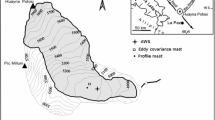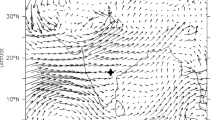Abstract
A nocturnal gravity wave was detected over a south-western Amazon forest during the Large-Scale Biosphere–Atmosphere experiment in Amazonia (LBA) in the course of the dry-to-wet season campaign on October 2002. The atmospheric surface layer was stably stratified and had low turbulence activity, based on friction velocity values. However, the passage of the wave, an event with a period of about 180–300 s, caused negative turbulent fluxes of carbon dioxide (CO2) and positive sensible heat fluxes, as measured by the eddy-covariance system at 60 m (≈30 m above the tree tops). The evolution of vertical profiles of air temperature, specific humidity and wind speed during the wave movement revealed that cold and drier air occupied the sub-canopy space while high wind speeds were measured above the vegetation. The analysis of wind speed and scalars high frequency data was performed using the wavelet technique, which enables the decomposition of signals in several frequencies allowed by the data sampling conditions. The results showed that the time series of vertical velocity and air temperature were −90° out of phase during the passage of the wave, implying no direct vertical transport of heat. Similarly, the time series of vertical velocity and CO2 concentration were 90° out of phase. The wave was not directly associated with vertical fluxes of this variable but the mixing induced by its passage resulted in significant exchanges in smaller scales as measured by the eddy-covariance system. The phase differences between horizontal velocity and both air temperature and CO2 concentration were, respectively, zero and 180°, implying phase and anti-phase relationships. As a result, the wave contributed to positive horizontal fluxes of heat and negative horizontal fluxes of carbon dioxide. Such results have to be considered in nocturnal boundary-layer surface-atmosphere exchange schemes for modelling purposes.
Similar content being viewed by others
References
Andreae MO, Artaxo P, Brandao C, Carswell FE, Ciccioli P, da Costa AL, Culf AD, Esteves JL, Gash JHC, Grace J, Kabat P, Lelieveld J, Malhi Y, Manzi AO, Meixner FX, Nobre AD, Nobre C, Ruivo MDLP, Silva-Dias MA, Stefani P, Valentini R, von Jouanne J, Waterloo MJ (2002) Biogeochemical cycling of carbon, water, energy, trace gases, and aerosols in Amazonia: the LBA-EUSTACH experiments. J Geophys Res Atmos 107(D20): 8066
Blumen W, Banta R, Burns SP, Fritts DC, Newsom R, Poulos GS, Sun JL (2001) Turbulence statistics of a Kelvin-Helmholtz billow event observed in the night-time boundary layer during the Cooperative Atmosphere-Surface Exchange Study field program. Dyn Atmos Oceans 34(2–4): 189–204
Bolzan MJA, Vieira PC (2006) Wavelet analysis of the wind velocity and temperature variability in the Amazon forest. Braz J Phys 36(4A): 1217–1222
Businger JA (1986) Evaluation of the accuracy with which dry deposition can be measured with current micrometeorological techniques. J Clim Appl Meteorol 25(8): 1100–1124
Cava D, Giostra U, Siqueira M, Katul G (2004) Organised motion and radiative perturbations in the nocturnal canopy sublayer above an even-aged pine forest. Boundary-Layer Meteorol 112(1): 129–157
Chimonas G (1985) Apparent counter-gradient heat fluxes generated by atmospheric waves. Boundary-Layer Meteorol 31(1): 1–12
Collineau S, Brunet Y (1993a) Detection of turbulent coherent motions in a forest canopy. 1. Wavelet analysis. Boundary-Layer Meteorol 65(4): 357–379
Collineau S, Brunet Y (1993b) Detection of turbulent coherent motions in a forest canopy. 2. Time-scales and conditional averages. Boundary-Layer Meteorol 66(1–2): 49–73
Cuxart J, Yagüe C, Morales G, Terradellas E, Orbe J, Calvo J, Fernández A, Soler MR, Infante C, Buenestado P, Espinalt A, Joergensen HE, Rees JM, Vilá J, Redondo JM, Cantalapiedra IR, Conangla L (2000) Stable atmospheric boundary-layer experiment in Spain (SABLES 98): a report. Boundary-Layer Meteorol 96(3):337–370, http://dx.doi.org/10.1023/A:1002609509707
Daubechies I (1992) Ten lectures on wavelets. CBMS-NSF regional conference series in applied mathematics, vol 61. Society for Industrial and Applied Mathematics, Philadelphia, PA, 377 pp
Farge M (1992) Wavelet transforms and their applications to turbulence. Annu Rev Fluid Mech 24: 395–457
Finnigan J (1988) Kinetic-energy transfer between internal gravity-waves and turbulence. J Atmos Sci 45(3): 486–505
Fisch G, Tota J, Machado LAT, Dias MAFS, Lyra RFD, Nobre CA, Dolman AJ, Gash JHC (2004) The convective boundary layer over pasture and forest in Amazonia. Theor Appl Climatol 78(1–3): 47–59
Fitzjarrald DR, Moore KE (1990) Mechanisms of nocturnal exchange between the rain forest and the atmosphere. J Geophys Res 95(D10):16,839–16,850. http://dx.doi.org/10.1029/JD095iD10p16839
Foken T, Goeckede M, Mauder M, Mahrt L, Amiro BD, Munger JW (2004) Post-field data quality control. In: Lee X, Massman WJ, Law B (eds) Handbook of micrometeorology: a guide for surface flux measurement and analysis.. Kluwer, Dordrecht, pp 250
Froelich NJ, Schmid HP (2006) Flow divergence and density flows above and below a deciduous forest: part II. Below-canopy thermotopographic flows. Agric For Meteorol 138(1–4): 29–43
Garratt JR (1990) The internal boundary layer—a review. Boundary-Layer Meteorol 50(1):171–203. http://dx.doi.org/10.1007/BF00120524
Garratt JR (1992) The atmospheric boundary layer. Cambridge University Press, Cambridge, p 316
Garstang M, White S, Shugart HH, Halverson J (1998) Convective cloud downdrafts as the cause of large blowdowns in the Amazon rainforest. Meteorol Atmos Phys 67(1):199–212. http://dx.doi.org/10.1007/BF01277510
Gash JHC, Nobre CA, Roberts J, Victoria RL (1996) Amazonian deforestation and climate. Wiley, New York, p 611
Grinsted A, Moore JC, Jevrejeva S (2004) Application of the cross wavelet transform and wavelet coherence to geophysical time series. Nonlinear Process Geophys 11(5–6): 561–566
Horst TW, Weil JC (1994) How far is far enough? The fetch requirements for micrometeorological measurement of surface fluxes. J Atmos Ocean Technol 11(4): 1018–1025
Hu X, Lee X, Stevens DE, Smith RB (2002) A numerical study of nocturnal wavelike motion in forests. Boundary-Layer Meteorol 102(2):199–223. http://dx.doi.org/10.1023/A:1013167228992
Kaimal JC, Finnigan JJ (1994) Atmospheric boundary layer flows: their structure and measurement. Oxford University Press, New York, p 289
Katul G, Vidakovic B (1998) Identification of low-dimensional energy containing flux transporting eddy motion in the atmospheric surface layer using wavelet thresholding methods. J Atmos Sci 55(3): 377–389
Knohl A, Schulze ED, Kolle O, Buchmann N (2003) Large carbon uptake by an unmanaged 250-year-old deciduous forest in Central Germany. Agric For Meteorol 118(3–4): 151–167
Kruijt B, Malhi Y, Lloyd J, Norbre AD, Miranda AC, Pereira MGP, Culf A, Grace J (2000) Turbulence statistics above and within two Amazon rain forest canopies. Boundary-Layer Meteorol 94(2): 297–331
Leclerc MY, Thurtell GW (1990) Footprint prediction of scalar fluxes using a Markovian analysis. Boundary-Layer Meteorol 52(3):247–258. http://dx.doi.org/10.1007/BF00122089
Lee X (1997) Gravity waves in a forest: a linear analysis. J Atmos Sci 54(21): 2574–2585
Lee XH, Black TA, denHartog G, Neumann HH, Nesic Z, Olejnik J (1996) Carbon dioxide exchange and nocturnal processes over a mixed deciduous forest. Agric For Meteorol 81(1–2): 13–29
Lee X, Neumann HH, DenHartog G, Fuentes JD, Black TA, Mickle RE, Yang PC, Blanken PD (1997) Observation of gravity waves in a boreal forest. Boundary-Layer Meteorol 84(3): 383–398
Liu Y, Liang XS, Weisberg RH (2007) Rectification of the bias in the wavelet power spectrum. J Atmos Ocean Technol 24(12): 2093–2102. doi:10.1175/2007JTECHO511.1
Lu CH, Fitzjarrald DR (1994) Seasonal and diurnal-variations of coherent structures over a deciduous forest. Boundary-Layer Meteorol 69(1–2): 43–69
Lu NP, Neff WD, Kaimal JC (1983) Wave and turbulence structure in a disturbed nocturnal inversion. Boundary-Layer Meteorol 26(2): 141–155
Meillier YP, Frehlich RG, Jones RM, Balsley BB (2008) Modulation of small-scale turbulence by ducted gravity waves in the nocturnal boundary layer. J Atmos Sci 65(4): 1414–1427
Moore CJ (1986) Frequency response corrections for eddy correlation systems. Boundary-Layer Meteorol 37(1):17–35. http://dx.doi.org/10.1007/BF00122754
Nogueira DS, Sá LDA, Cohen JCP (2006) Rajadas noturnas e trocas de CO2 acima da floresta de Caxiuanã, PA, durante a estação seca. Rev Bras Meteorol 21(3b): 213–223
Poulos GS, Blumen W, Fritts DC, Lundquist JK, Sun J, Burns SP, Nappo C, Banta R, Newsom R, Cuxart J, Terradellas E, Balsley B, Jensen M (2002) CASES-99: a comprehensive investigation of the stable nocturnal boundary layer. Bull Am Meteorol Soc 83(4): 555–581
Prabha T, Leclerc M, Karipot A, Hollinger D, Mursch-Radlgruber E (2008) Influence of nocturnal low-level jets on eddy-covariance fluxes over a tall forest canopy. Boundary-Layer Meteorol 126(2): 219–236
Rees JM, Anderson PS, King JC (1998) Observations of solitary waves in the stable atmospheric boundary layer. Boundary-Layer Meteorol 86(1): 47–61
Rees JM, Staszewski WJ, Winkler JR (2001) Case study of a wave event in the stable atmospheric boundary layer overlying an Antarctic Ice Shelf using the orthogonal wavelet transform. Dyn Atmos Oceans 34(2–4): 245–261
Sá LDD, Sambatti SBM, Galvao GP (1998) Applying the Morlet wavelet in a study of variability of the level of Paraguay River at Ladario, MS. Pesqui Agropecu Bras 33: 1775–1785
Schotanus P, Nieuwstadt FTM, Debruin HAR (1983) Temperature-measurement with a sonic anemometer and its application to heat and moisture fluxes. Boundary-Layer Meteorol 26(1): 81–93
Silva Dias MAF, Rutledge S, Kabat P, Silva Dias PL, Nobre C, Fisch G, Dolman AJ, Zipser E, Garstang M, Manzi AO, Fuentes JD, Rocha HR, Marengo J, Plana-Fattori A, Sa LDA, Alvala RCS, Andreae MO, Artaxo P, Gielow R, Gatti L (2002) Cloud and rain processes in a biosphere–atmosphere interaction context in the Amazon region. J Geophys Res Atmos 107(D20): 8072
Stull RB (1988) An introduction to boundary layer meteorology. Kluwer, Dordrecht, p 666
Sun JL, Burns SP, Lenschow DH, Banta R, Newsom R, Coulter R, Frasier S, Ince T, Nappo C, Cuxart J, Blumen W, Lee X, Hu XZ (2002) Intermittent turbulence associated with a density current passage in the stable boundary layer. Boundary-Layer Meteorol 105(2): 199–219
Sun JL, Lenschow DH, Burns SP, Banta RM, Newsom RK, Coulter R, Frasier S, Ince T, Nappo C, Balsley BB, Jensen M, Mahrt L, Miller D, Skelly B (2004) Atmospheric disturbances that generate intermittent turbulence in nocturnal boundary layers. Boundary-Layer Meteorol 110(2): 255–279
Terradellas E, Soler MR, Ferreres E, Bravo M (2005) Analysis of oscillations in the stable atmospheric boundary layer using wavelet methods. Boundary-Layer Meteorol 114(3): 489–518
Thomas C, Foken T (2005) Detection of long-term coherent exchange over spruce forest using wavelet analysis. Theor Appl Climatol 80(2–4): 91–104
Torrence C, Compo GP (1998) A practical guide to wavelet analysis. Bull Am Meteorol Soc 79(1): 61–78
Viana S, Yagüe C, Maqueda G (2009) Propagation and effects of a mesoscale gravity wave over a weakly-stratified nocturnal boundary layer during the SABLES2006 field campaign. Boundary-Layer Meteorol 133(2): 165–188
von Randow C, Sa LDA, Gannabathula PSSD, Manzi AO, Arlino PRA, Kruijt B (2002) Scale variability of atmospheric surface layer fluxes of energy and carbon over a tropical rain forest in southwest Amazonia—1. Diurnal conditions. J Geophys Res-Atmos 107(D20): 8062
von Randow C, Manzi AO, Kruijt B, de Oliveira PJ, Zanchi FB, Silva RL, Hodnett MG, Gash JHC, Elbers JA, Waterloo MJ, Cardoso FL, Kabat P (2004) Comparative measurements and seasonal variations in energy and carbon exchange over forest and pasture in South West Amazonia. Theor Appl Climatol 78(1–3): 5–26
Webb EK, Pearman GI, Leuning R (1980) Correction of flux measurements for density effects due to heat and water-vapor transfer. Q J Roy Meteorol Soc 106(447): 85–100
Zeri M, Sá LDA (2010) The impact of data gaps and quality control filtering on the balances of energy and carbon for a Southwest Amazon forest. Agric For Meteorol 150: 1543–1552
Author information
Authors and Affiliations
Corresponding author
Rights and permissions
About this article
Cite this article
Zeri, M., Sá, L.D.A. Horizontal and Vertical Turbulent Fluxes Forced by a Gravity Wave Event in the Nocturnal Atmospheric Surface Layer Over the Amazon Forest. Boundary-Layer Meteorol 138, 413–431 (2011). https://doi.org/10.1007/s10546-010-9563-3
Received:
Accepted:
Published:
Issue Date:
DOI: https://doi.org/10.1007/s10546-010-9563-3




